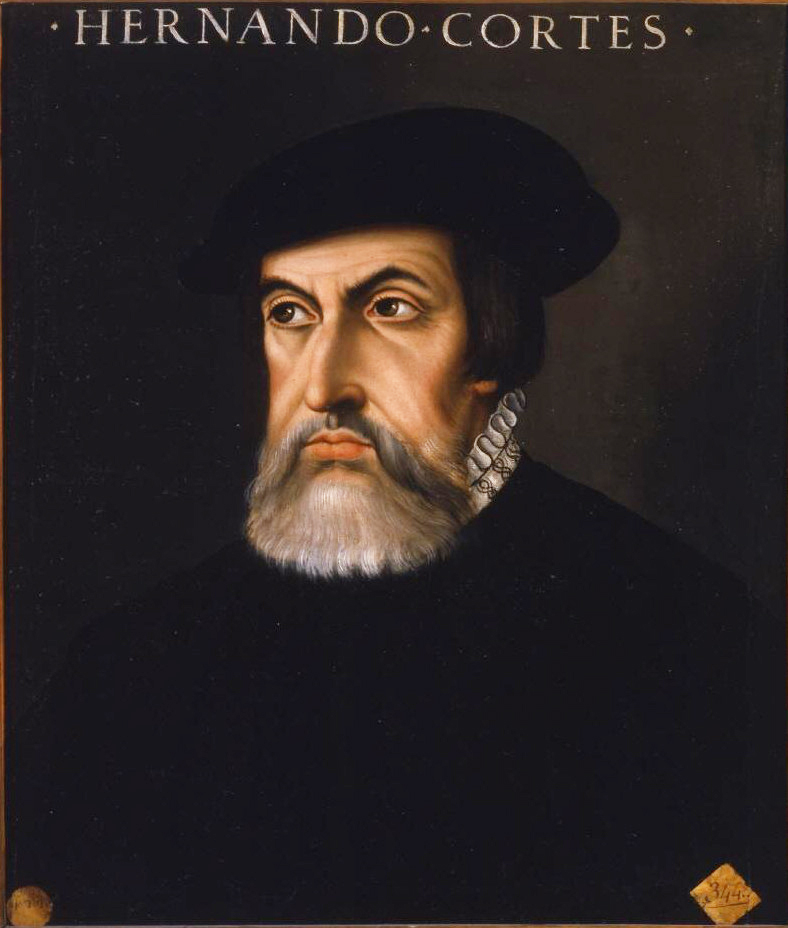While California has only been an American state since 1850, California has been known as a place of sunshine, gold, and riches since the early 16th century...in literature, at any rate.
 |
| Map of California, 1650, Johannes Vingboos. Public Domain. The compass rose is pointing to the approximate location of modern day San Diego. |
Renaissance-era Europeans were entranced, and believed the account must be true. In 1533, explorer Fortún Ximénez discovered the southern portion of what is now Baja California--a peninsula that was often mistaken for an island for quite some time. He died, but two years later, Hernán Cortés arrived at the bay, attempting to start a colony there. Even though the native population (which included men) weren't dripping with gold jewelry, the idea that this must be the fabled California stuck.
 |
| Conquistador Hernán Cortés by Paolo Giovio. Public Domain. |
 |
| Satellite view of Baja California. Public Domain. |
It wasn't until almost a hundred years later that a Jesuit missionary and cartographer, Father Eusebius Francisco Kino, set off to find new people and eventually came to the Colorado River, near what is now Yuma, Arizona. He proved California was fixed to the rest of the continent, but the matter was not entirely put to rest until the time of the American Revolutionary War, around 1775, when Juan Bautista de Anza explored the area between Sonora and California coast.
 |
| Juan Bautista de Anza, photographic reproduction of an oil painting by Fray Orsi, 1774. Public Domain. |
***

California native Susanne Dietze is a RITA-nominated author who's seen her books on the ECPA and Publisher's Weekly Bestseller lists for inspirational fiction. Her latest novel is The Blizzard Bride. Learn more about her on her website, www.susannedietze.com.


Thanks for the post! It reminds me of the cartoon where three blind men are touching an elephant and try to describe it by what they feel!!! Knowledge is important! I can't believe the myth of California as an island lasted so long.
ReplyDeleteHi Connie! I, too, was surprised by the legend...and that it lasted for so long, even after an expedition to the Colorado River disproved the idea that it was an island.
DeleteIt's a fascinating story to explain the name!
Fascinating indeed. I never thought of California as an island. Actually, I never thought of that stretch of land at all until I discovered through family history research that a distant cousin of hubby's had lived there. Thanks for the great post.
ReplyDeleteYears ago, I'd heard California was named for a mythical island. Much later, I learned California was believed to be that mythical island, even though it wasn't really an island!
DeleteWhere did his distant cousin live?
Thanks, Anita Mae!
This is nothing to brag about, but his Draft registration card shows he lived at a hotel in Calexico and worked at a notorious...ahem...place...in Mexicali.
DeleteOh! Wow! Genealogy is so fascinating--we learn so much about how people lived. Thank you for sharing!
DeleteThis is so interesting. It does prove that those early map-makers only mapped what they saw and how they influenced others enough to make the legend go on for so long. Baja has alwas fascinated me at how it juts out and does look like it could be an island without the big picture.
ReplyDeleteThanks, Martha! I'm always amazed and impressed by the work of early map-makers. Some centuries old maps are incredibly accurate! Others? Not so much! I can definitely see why they thought Baja could be an island, however, especially since they were influenced by the legend.
DeleteThanks for saying hi!